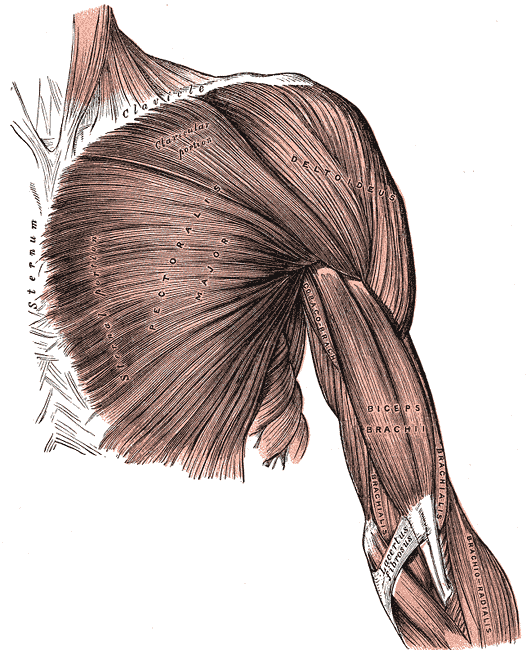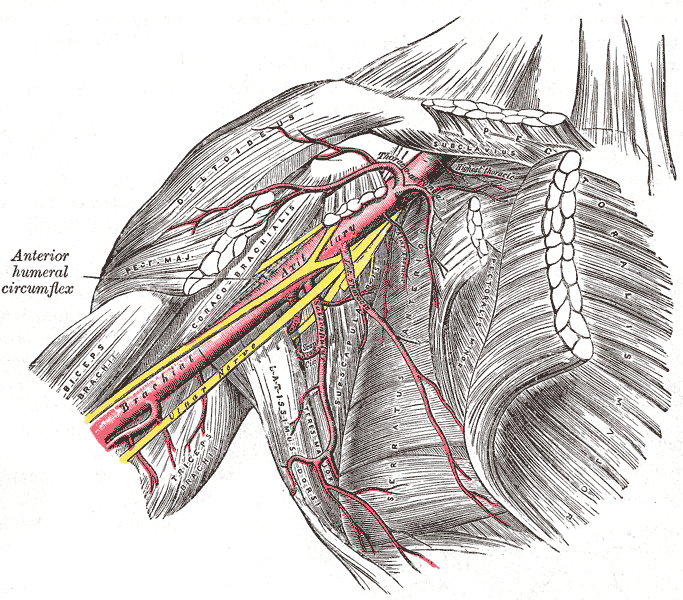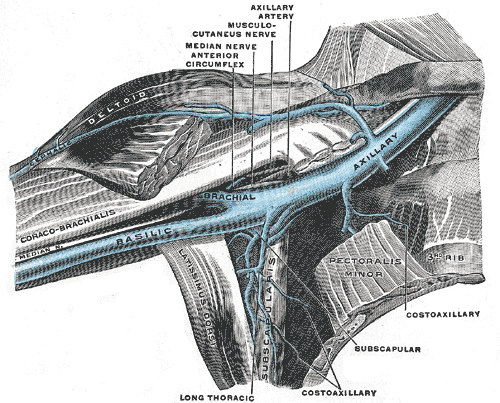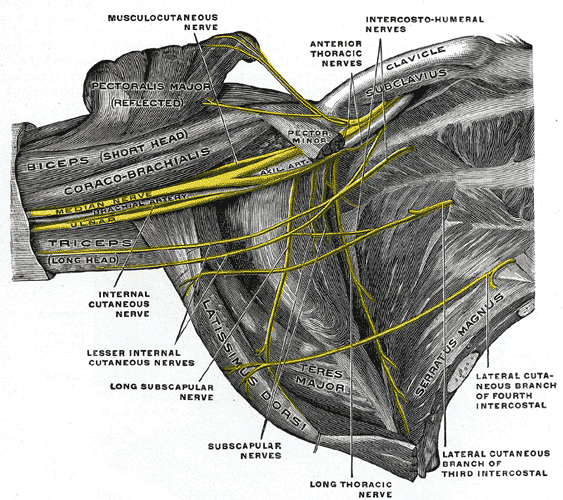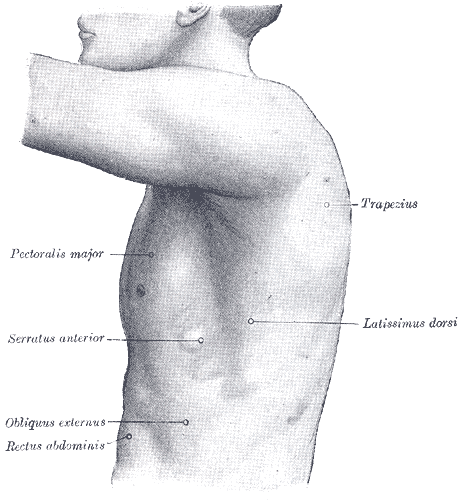Axilla
Template:Infobox Anatomy Editor-In-Chief: C. Michael Gibson, M.S., M.D. [1]
Overview
The axilla (or armpit, underarm, or oxter) is the area on the human body directly under the joint where the arm connects to the shoulder.
Boundaries
Anatomically, the boundaries are as follows:
| inlet/apex: by the outer border of first rib, superior border of scapula, and posterior border of clavicle[[#cite_note-titleAnaesthesia_UK_:�AnaesthesiaUK:_Applied_anatomy_for_upper_limb_blocks-1|[1]]] | ||
| medially: serratus anterior [2] and by the ribcage | anteriorly: by the pectoralis major, minor,[3] and subclavius [2] (see also anterior axillary fold)
posteriorly: by the subscapularis above, and teres major and latissimus dorsi below[2] (see also posterior axillary fold) |
laterally: by the intertubercular sulcus [3] (coracobrachialis and the short head of the biceps brachii are in the axilla.)[2] |
| floor/base: by the skin[[#cite_note-titleAnaesthesia_UK_:�AnaesthesiaUK:_Applied_anatomy_for_upper_limb_blocks-1|[1]]] (visible surface of armpit) |
Underarm hair

Underarm hair usually grows in the underarms of both females and males, beginning in adolescence.
In modern Western culture, it is common for women to remove underarm hair for aesthetic reasons, while men tend to keep it. Throughout the feminist movement, previously in the hippie culture, and in some areas of the punk rock scene, some women choose to keep their underarm hair for a variety of reasons, from subversion to egalitarianism to comfort.
Recently, many men in the U.S. and Europe have begun to remove underarm hair due to popularization by hairless male models and athletes, and thinking it is embarrassing if they show it when wearing a sleeveless shirt.
Body odor
Body odor develops in the underarms due in part to the waste products of microorganisms that feed on sebum, the fatty secretions produced by apocrine glands.
A wide variety of deodorant and antiperspirant products are sold for the purpose of mitigating this odor.
Cultural significance
The underarms are among the locations in the human body which are most vulnerable to tickling.
The sexual attraction to the underarms is called axillism.
Terminology
The term oxter, pronounced 'ock-ster' is most often used in Scotland,[4] northern England, and Ireland. Northern Ireland generally replaces all other names of underarm for oxter.
The term "underarm" only refers to the outer surface of the axilla.[5] However, the terms are sometimes used interchangeably in casual contexts.
Colloquially, armpit refers to an object or place which is smelly, greasy or otherwise undesirable.[6]
Additional images
-
Superficial muscles of the chest and front of the arm.
-
Axillary artery and its branches - anterior view of right upper limb and thorax.
-
The veins of the right axilla, viewed from in front.
-
The right brachial plexus (infraclavicular portion) in the axillary fossa; viewed from below and in front.
-
The left side of the thorax.
References
- ↑ [[#cite_ref-titleAnaesthesia_UK_:�AnaesthesiaUK:_Applied_anatomy_for_upper_limb_blocks_1-0|1.0]] [[#cite_ref-titleAnaesthesia_UK_:�AnaesthesiaUK:_Applied_anatomy_for_upper_limb_blocks_1-1|1.1]] [http://www.anaesthesiauk.com/article.aspx?articleid=100359 "Anaesthesia UK :�AnaesthesiaUK: Applied anatomy for upper limb blocks"]. Retrieved 2007-12-23. replacement character in
|title=at position 17 (help) - ↑ 2.0 2.1 2.2 2.3 "LAB #4 PECTORAL REGION & Introduction to the Axilla". Retrieved 2007-12-23.
- ↑ 3.0 3.1 "Dissector Answers - Axilla and Arm". Retrieved 2007-12-23.
- ↑ "BBC - Voices - Multilingual Nation". Retrieved 2007-12-23.
- ↑ Template:Dorlands
- ↑ "Definition of armpit - Merriam-Webster Online Dictionary". Retrieved 2007-12-23.
External links
ar:إبط de:Achsel eo:Akselo gd:Achlais ko:겨드랑이 id:Ketiak it:Ascella (anatomia) la:Axilla lt:Pažastis nl:Oksel scn:Ascidda fi:Kainalo sv:Armhåla tl:Kilikili
